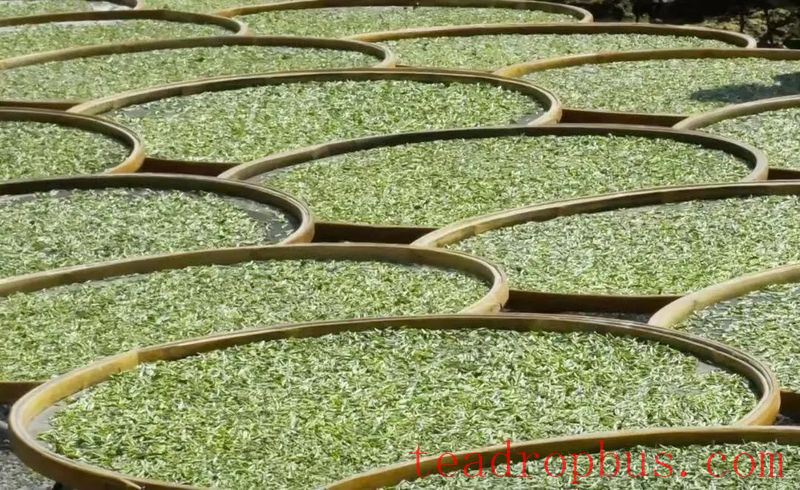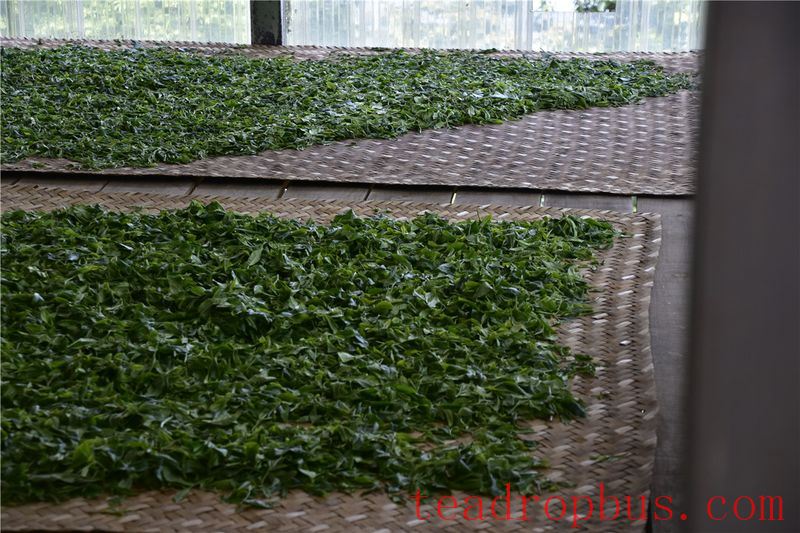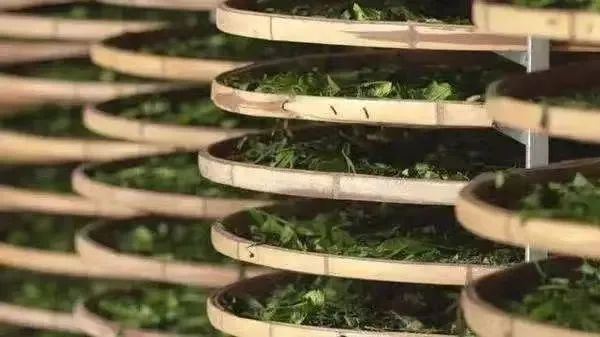Wilt is the “soul” of White Tea processing, and the quality of the wilt directly determines the quality of the finished white Tea. Wilt generally occurs under certain temperature, humidity, and ventilation conditions, involving the evaporation of water from the leaves and respiration, during which the internal substances in the leaves undergo a slow process of hydrolysis and oxidation. During this process, the tea emits a green scent, enhancing its aroma, giving off a sweet and mellow “wilt fragrance,” which plays an important role in the quality of white tea. There are mainly four methods of wilting: sun wilting, natural indoor wilting, heated wilting, and composite wilting.
I. Sun Wilt
If the weather is clear, most Fuding white teas are sun-wilted. During the wilt, the tea shoots are thinly spread evenly on bamboo trays or water sieves. A bamboo tray is a rectangular bamboo tool that is 2.2 to 2.4 meters long and 70 to 80 centimeters wide, made by weaving bamboo strips 0.2 to 0.3 centimeters wide. The tray has gaps but no holes, making it the ideal structure for white tea wilting as it allows air to circulate above and below the tea, ensuring the quality of the white tea. A water sieve is a large bamboo sieve with large holes, about 100 centimeters in diameter, with each hole approximately 0.5 centimeters square and bamboo strips around 1 centimeter wide. The tea shoots should not overlap when laid out, as the overlapping parts will turn black. After spreading them out, they are placed on a rack and exposed to sunlight for natural wilting. They should not be turned by hand to avoid mechanical damage to the tea shoots, which could cause them to turn red or damage the downy hair on the shoots; they should also not be placed on the ground to prevent obstructing air circulation and prolonging the wilting time. The total duration of the wilt ranges from 48 to 72 hours, and the tea master adjusts it based on experience, observing factors such as the climate, the moisture content of the tea, color changes, and dryness.

II. Natural Indoor Wilt
In the Zhenghe white tea production area, natural indoor wilting is more commonly used. The wilting room must have ventilation on all sides, no direct sunlight, and protection against rain and mist intrusion. The location must be clean and hygienic and able to control temperature and humidity. For Spring Tea, the room temperature should be between 20 and 30°C, typically around 25°C, with relative humidity between 55% and 70%. For summer and autumn teas, the room temperature should be controlled between 30 and 32°C, with relative humidity between 60% and 75%. The duration of natural indoor wilting is typically 52 to 60 hours. On rainy days, the duration of natural indoor wilting should not exceed three days, otherwise the shoots will mold and turn black; on sunny and dry days, the wilting time should not be less than two days, otherwise the finished tea will have a greenish scent, a bitter taste, and poor quality. Due to the longer time required for natural wilting, it occupies a large area of factory space, requires a lot of equipment, and is affected by natural climate conditions, making it unsuitable for mass production and limiting its application range.
Spreading Out
After fresh leaves arrive at the factory, they must be strictly separated according to their age and promptly wilted separately. When white tea is wilted, the fresh leaves are spread out on water sieves, a process commonly known as “spreading out” or “opening the green.” The method of spreading out: after placing the leaves on the water sieve, hold the edges of the sieve with both hands and rotate it to evenly distribute the leaves. Good spreading out can be achieved in one go, with the leaves spread out evenly. The action should be quick and gentle, avoiding repeated shaking to prevent mechanical damage to the tea leaves.
Due to the high technical requirements of spreading out, the fresh leaves can also be gently shaken onto the water sieve or bamboo curtain, but the movement should be gentle. The amount of leaves spread out per sieve is about 0.8 kilograms for spring tea and about 0.5 kilograms for summer and autumn teas. After laying out the leaves, the water sieves are placed on the wilting racks in the wilting room and should not be turned.

Merging Sieves
During natural indoor wilting, a process called “merging sieves” or “consolidation” should be performed once. Its main purpose is to promote the curling of the leaf margins, even out the moisture, slow down the rate of moisture loss, and promote color change. The timing for merging sieves is usually: when the white tea has wilted for 35 to 45 hours and is about seven to eight-tenths wilted, the leaves do not stick to the sieve, the downy hairs turn white, the leaf color changes from light green to gray-green or dark green, the leaf margins slightly curl inward, the shoots and tender stems form a “curled tail,” and the leaves resemble the shape of a boat bottom. When there is no green scent left, the merging of sieves can be carried out. For small-leaved white tea, two sieves are merged into one when they are about eight-tenths wilted. For large-leaved white tea, the merging is usually done twice: first when they are seven-tenths wilted (two sieves merged into one), and then again when they are eight-tenths wilted (two sieves merged into one). After merging the sieves, the wilted leaves are piled up to a thickness of 10 to 15 centimeters in a concave shape.
Piling Up
Lower-grade white teas use “piling up,” also known as “heap fermentation.” Lower-grade white teas in northern Fujian are typically processed using this method. When piling up, the moisture content of the wilted leaves and the pile thickness must be controlled. The moisture content of the wilted leaves should not be lower than 20%, otherwise, they will not “change color.” The pile thickness depends on the moisture content: if the moisture content is around 30%, the pile thickness should be 10 centimeters; if the moisture content is around 25%, the pile thickness should be 20 to 30 centimeters. After merging the sieves, the wilted leaves are still placed on the racks and continue to wilt. Generally, about 12 to 14 hours after merging the sieves, the moisture in the stems significantly decreases, the leaves become soft, the leaf color turns gray-green, and when they are nine-tenths wilted, they can be removed from the sieve and sorted.

Sorting
When sorting, the movements should be gentle to prevent the shoots from breaking. The higher the grade of the rough tea, the stricter the sorting requirements. When making high-grade Bai Mudan, wax leaves, yellow leaves, red leaves, coarse old leaves, and foreign matter should be picked out; when making Grade 1 Bai Mudan, wax leaves, red leaves, stem pieces, and foreign matter should be removed; when making Grade 2 Bai Mudan, only red leaves and foreign matter should be removed; when making Grade 3 Bai Mudan, only stem pieces and foreign matter should be picked out; when making low-grade white tea, non-tea foreign matter should be removed.
III. Heated Wilt
If it rains continuously during the spring tea season, heated wilting must be used, which can be conducted through pipe heating or in a heated wilting chamber.
Pipe Heating Wilt
Pipe heating is conducted in a special “white tea pipe wilting room.” White tea hot air wilting consists of four parts: a heating stove, exhaust equipment, wilting curtains, and wilting racks. The wilting room is equipped with a hot air generator outside, and the hot air is evenly distributed indoors through pipes, raising the temperature in the wilting room. Typically, a wilting room with an area of 300 square meters can accommodate 1200 wilting curtains. The wilting curtains are made of woven